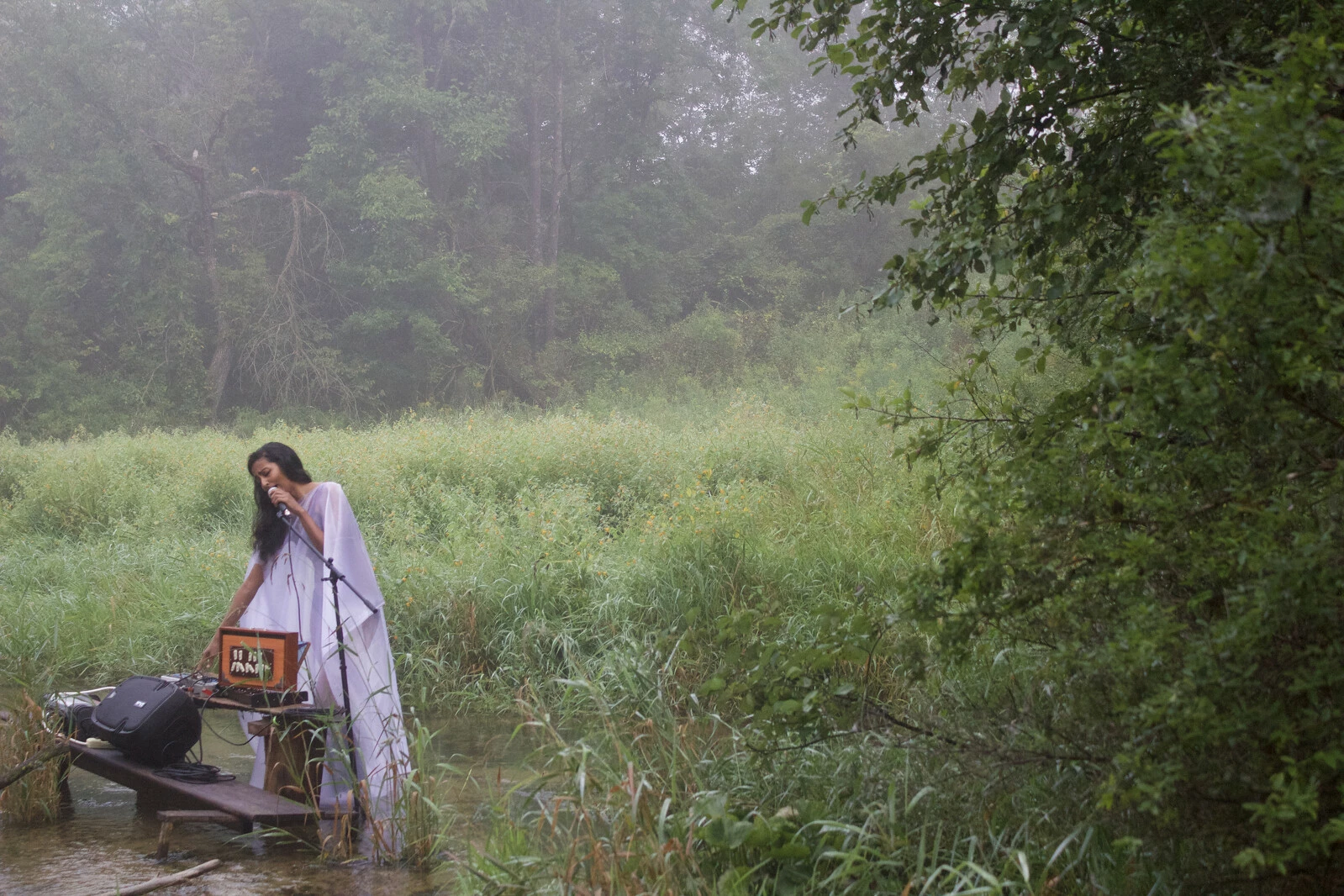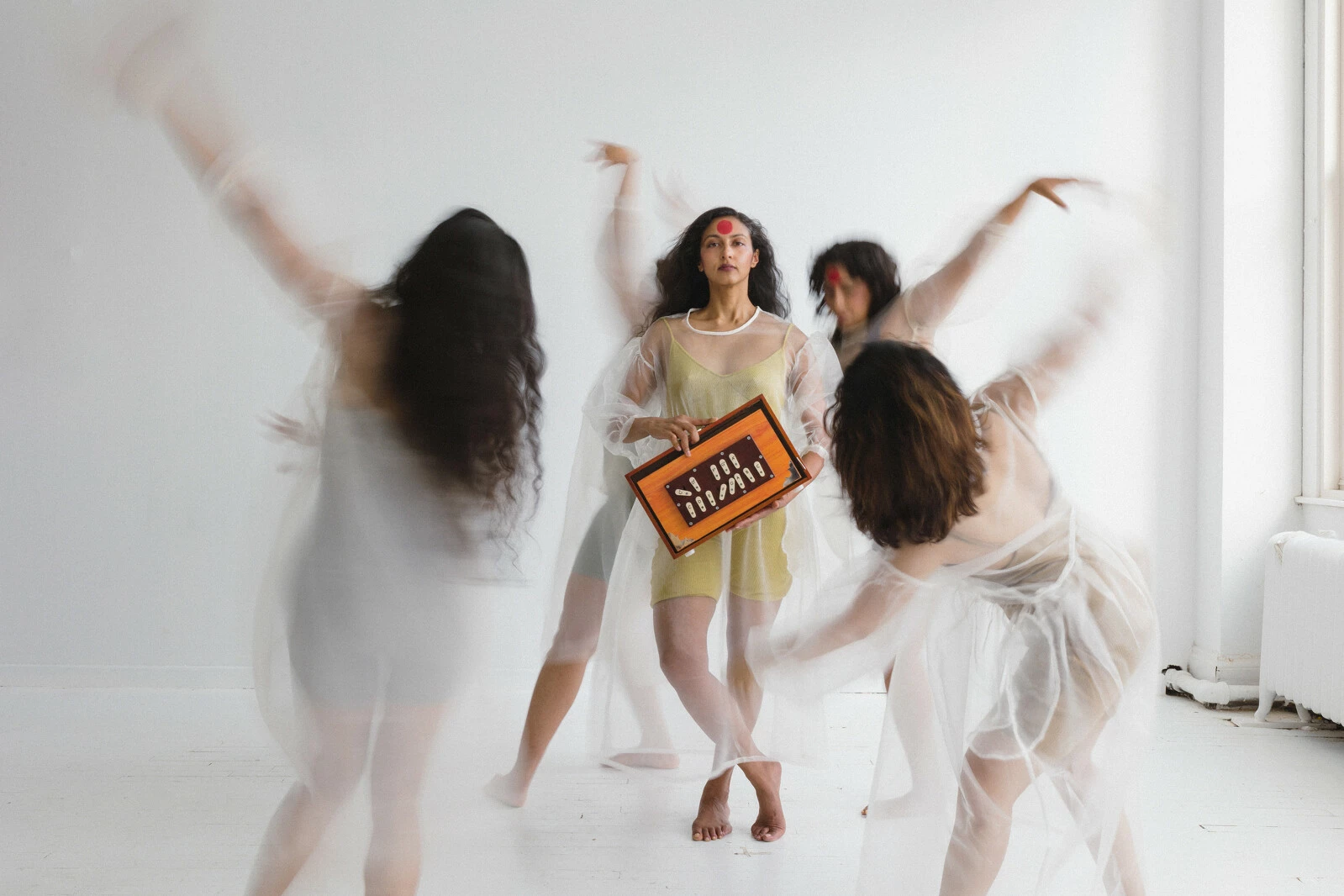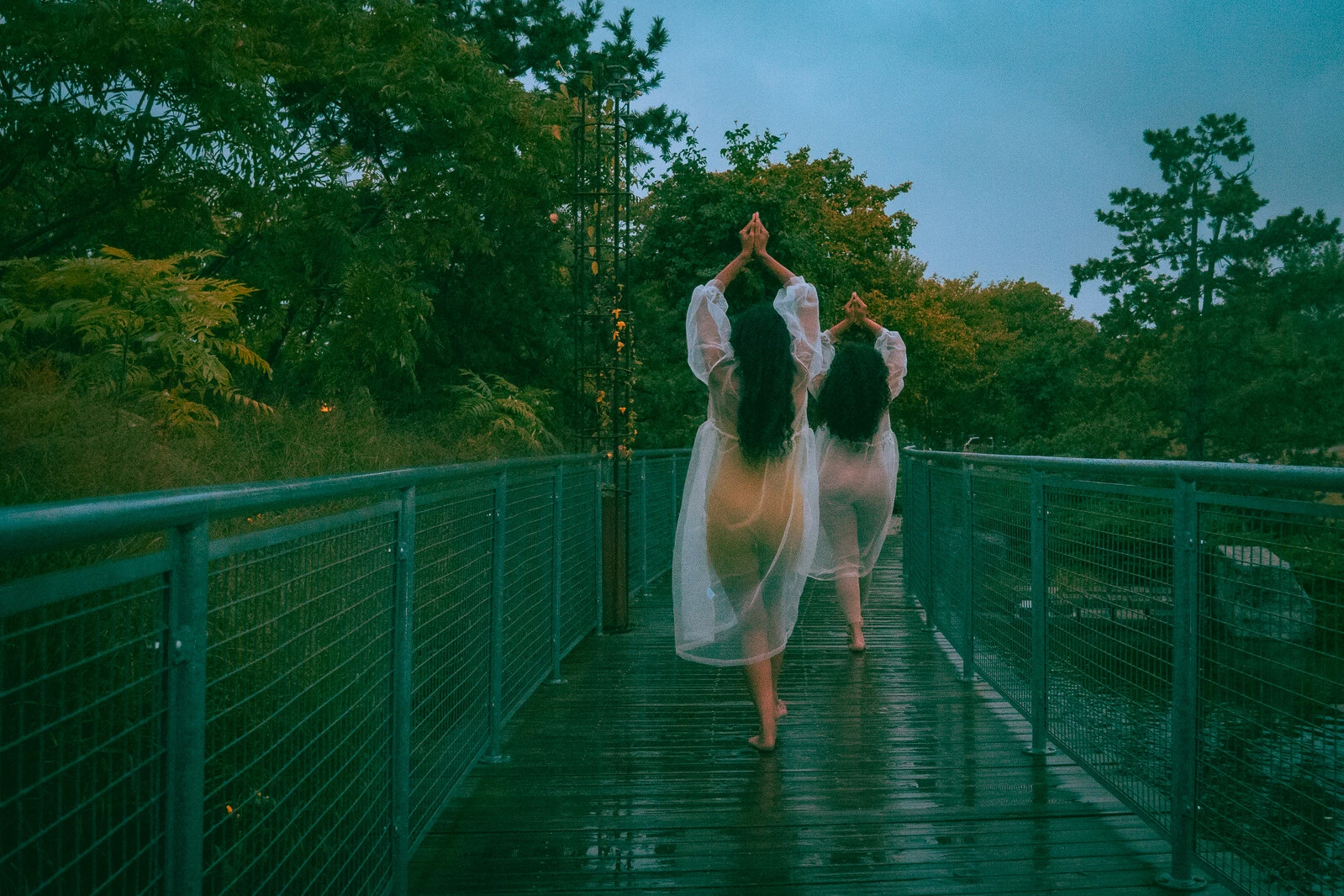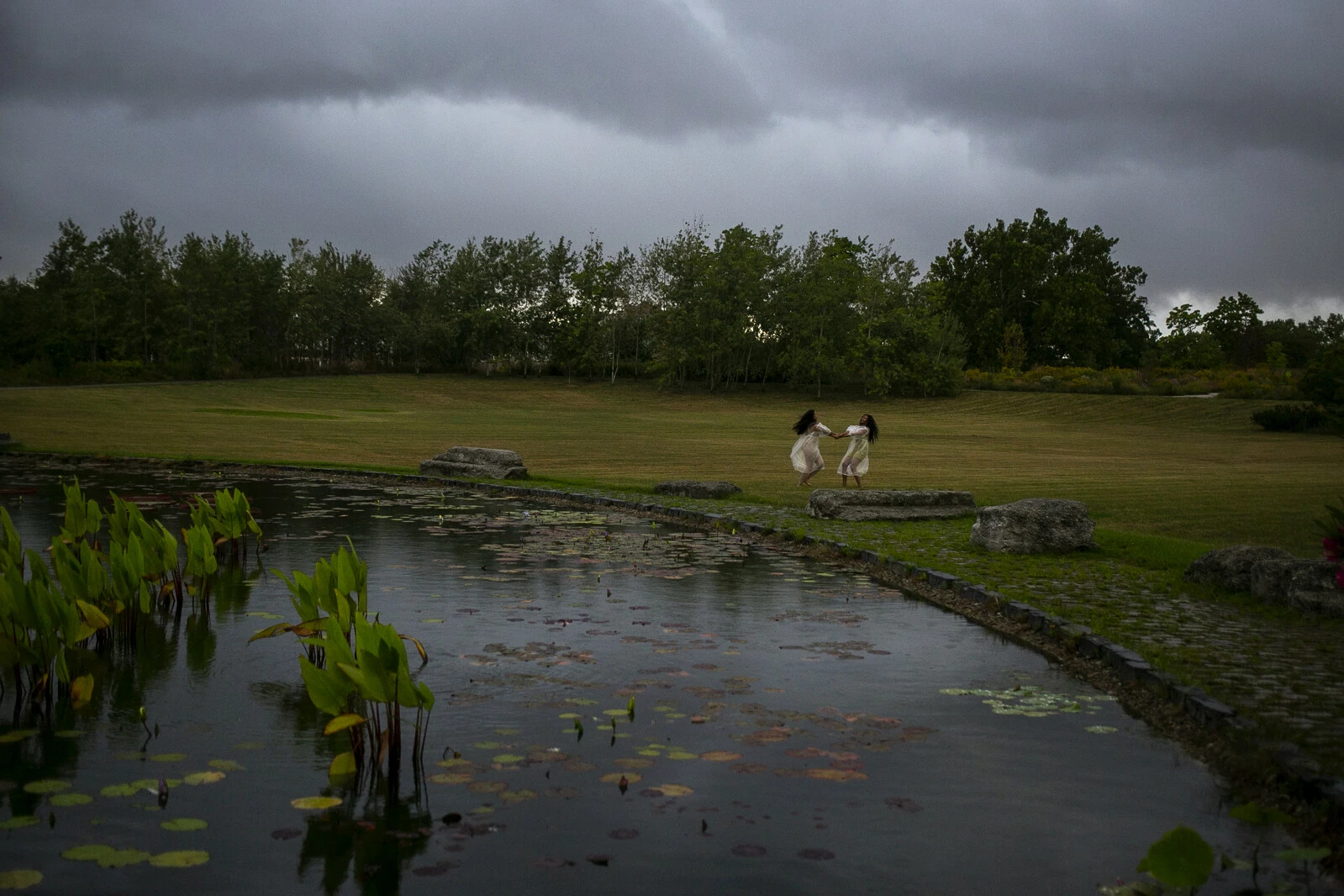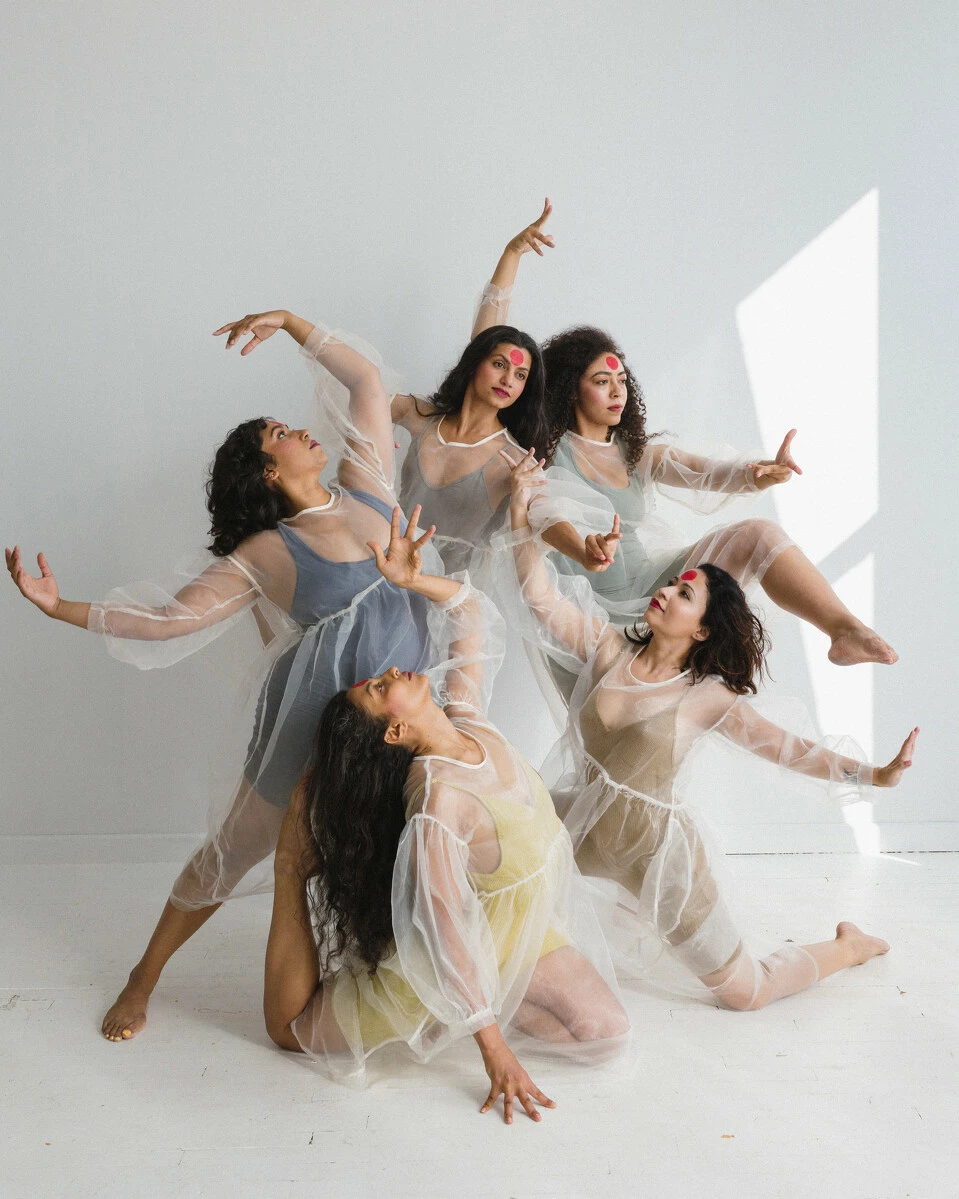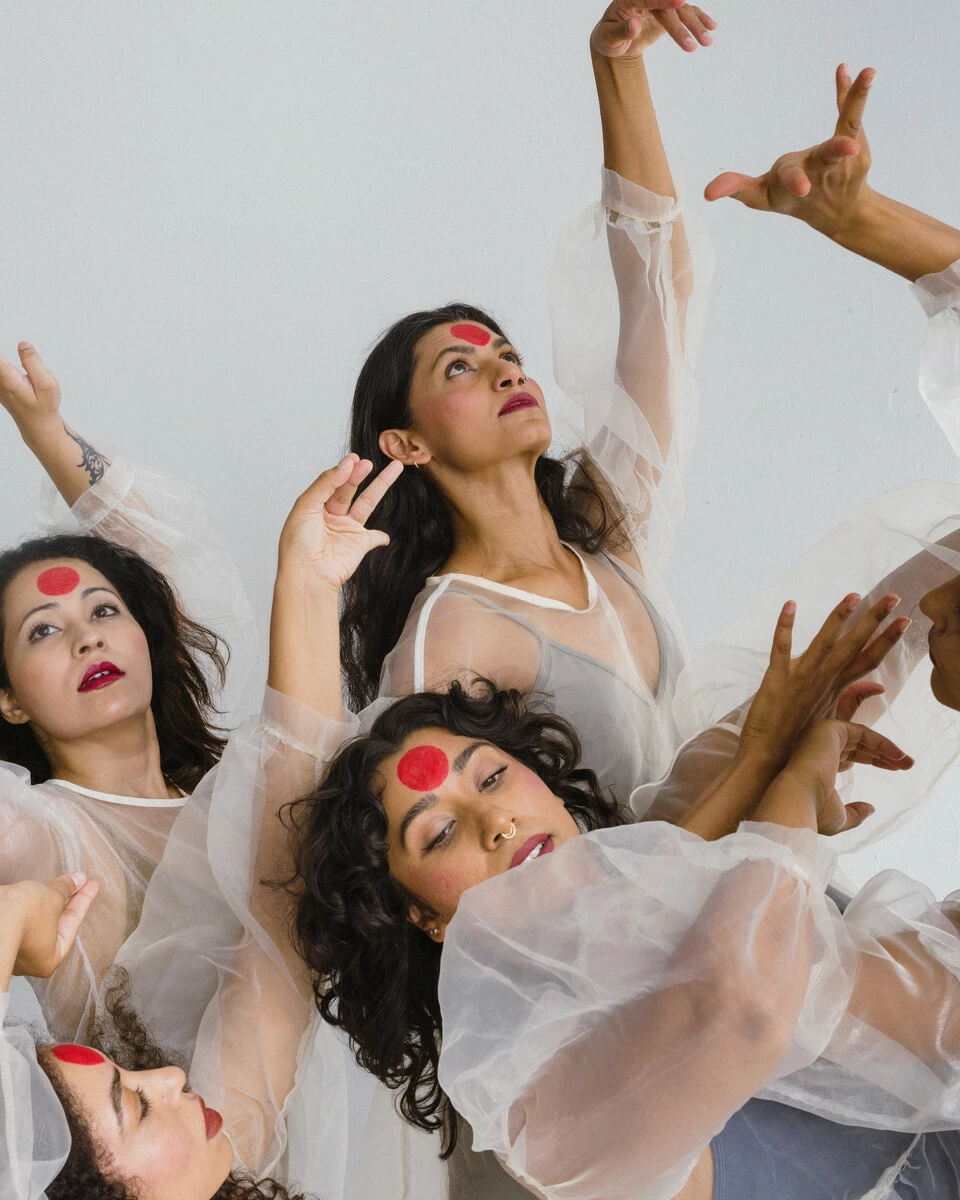CHICAGO PERFORMS 2024
Chicago Performs | Lykanthea, Some Viscera
September 26, 20247:30 pm
September 27, 20247:30 pm
CART captioning available Fri, Sep 27
Per the artist's request, masks must be worn during this performance.
Allergy notice: Live plants present
About the Performance
Lykanthea is a multidisciplinary collective led by artist Lakshmi Ramgopal, whose performances and installations use pop idioms to experiment with traditional South Asian art forms. Her latest work, Some Viscera, is a collection of song and movement that revolves around the death of her maternal grandmother, the births of her nieces, and her own ambivalent relationship with motherhood to explore childhood, kinship, and memory in the contemporary Indian-American diaspora after Indian independence. Presented through an immersive stage design, the project features a multidisciplinary ensemble starring Asha Rowland, Erica Miller, Johanna Brock, Ben Zucker, Lucy Little, Kinnari Vora, Shalaka Kulkarni, and Tuli Bera. Together, they integrate elements of Carnatic music, Bharatanatyam, ballet, medieval Sanskrit and modern Tamil poetry, Baroque chamber music, and free improvisation to perform rich, intimate dance theater.
Some Viscera occurs within the frame of the arangetram, a Tamil word meaning “ascending the stage.” It describes the arduous, long-form, solo performance through which students of classical Indian dance and music debut as mature artists. A celebrated yet fraught rite of passage, it is a profound, complex feature of life in the Indian-American diaspora. The arangetram of Some Viscera consists of four principal movements that invoke South Asian avian and floral motifs from a range of influences. Creating a fanciful, dreamy world, Some Viscera reflects on cultural knowledge and breakdown.
In 2019, Lykanthea presented an early iteration of Some Viscera as a part of the MCA’s In Progress series. This presentation of Some Viscera is dedicated to K. Nagalakshmi.
Masks must be worn during the performance per the artist’s request.
Access Information
English CART captioning is available for the performance on Friday, September 27.
Live plants, including roses and marigolds, are present during the performance. If you are concerned about allergies, please call the MCA Box Office for more information.
Program Notes
Billing
Lakshmi Ramgopal | Creative Lead, Director, Lyricist, Principal Choreographer, and Composer
Asha Rowland | Co-choreographer
Kitty Rauth | Production Manager
Additional musical composition and arrangement by Lucy Little, Johanna Brock, Erica Miller, and Lia Kohl
Musicians
Lakshmi Ramgopal | Vocals, Sruti box, and Glockenspiel
Asha Rowland | Vocals
Lucy Little | Violin and Vocals
Johanna Brock | Violin and Vocals
Erica Miller | Cello and Vocals
Ben Zucker | Vibraphone
Dancers
Lakshmi Ramgopal, Asha Rowland, Kinnari Vora, Tuli Bera, and Shalaka Kulkarni
About the Performers
Lykanthea is the project of multidisciplinary artist Lakshmi Ramgopal (she/her). Experimenting with traditional South Asian art forms, she creates long-form performances and installations at sites that range from galleries to botanical conservatories to the middle of a freshwater stream. Her work addresses the acquisition and transformation of knowledge through the natural environment, diasporic culture, the human life cycle, and the narrative form of history. In 2014 she released her debut EP Migration, which put her on the map among experimental and pop music fans for her alchemical use of synths, catchy melodies, vocal processing, and elements of Carnatic vocal techniques. Ramgopal has performed across the US and Europe, and her work has been commissioned by Krannert Art Museum, Chicago’s Museum of Contemporary Art, Experimental Sound Studio, and Edgar Miller Legacy.
Asha Rowland (she/her) is a multidisciplinary artist and dancer with a focus in Bharatanatyam, various African idioms of dance, Raq Sharqi (mentored by Sabah Saeed), hip-hop, and more. A disciple of Smt. Hema Rajagopalan and Smt. Krithika Rajagopalan of Natya Dance Theatre, she has been training in Bharatanatyam since the age of eight and completed her arangetram in 2014. Rowland’s work and movement has been a by-product of exploring her multiethnic heritage; driven by curiosity of cultural intersections, ancestry, and community connections. Rowland’s solo work is based in storytelling, world-creation, character development, puzzle-making, and mythology with a purpose of promoting social justice and illuminating imbalances in global power dynamics. Recently, Rowland was a part of the Choreographer’s Evening 2023 cohort at the Walker Art Center, where she showcased a section of her latest evening-length work, The Alchemist’s Soul, which will premiere in early 2025. She was a 2023–24 resident at the Cowles Center’s Generating Room program and a fellow of Black Ensemble Productions: the IFE Lab.
Erica Miller (she/they) is a cellist, electronic musician, and artist who often performs using free improvisation. Their work is a wide-ranging exploration of sonic landscapes and interwoven textures and drones.
Johanna Brock (she/they/he) is a Chicago-based composer, audio engineer, and multi-instrumentalist. A trained orchestral violist, Brock’s solo work takes inspiration from modern and canonical music for violin and viola. Using voice, synthesizers, viola, and audio samples, Brock’s music explores the boundaries between sound and linguistic meaning. Brock joined Lykanthea in 2018 and is also a member of the improvised string ensemble Akjai, the sound/art project Barbiefoot, and the music/movement project Lead Rocket with performer Sara Zalek. In June 2024 Brock was commissioned by the Chicago Film Archive to create an original film soundtrack alongside filmmaker Caitlin Ryan; their score for Kiss the Rest combines field recordings from Chicago with a neo-operatic duet for voice and viola. Brock’s eight-hour sound installation, created with visual artist Sofia Moreno, was featured in the gallery exhibition of Flores Nocturnas at the University of Wisconsin – Eau Claire in March 2024.
Ben Zucker (he/they) uses music to speculate on the systems and shapes of change, which has led to a wide-ranging career as a composer, multi-instrumentalist improviser, producer, and cultural worker. Acclaimed as a “master of improvisation” (IMPOSE Magazine), their work includes “stirring compositions . . . built on a lifetime of musical curiosity” (Chicago Reader), as well as numerous solo albums. As a performer, he utilizes vibraphone, brass, keys, voice, and electronics across styles. Highlights include performances with Anthony Braxton, Gareth Davis, the Vocal Constructivists, Karen Borca, Rinde Eckert, and Beth Orton, as well as frequent local appearances as an ensemble contributor and bandleader of experimental jazz quartet Fifth Season and creative music collective Mad Myth Science, the latter called “the next generation of Chicago jazz” by the Quietus. Following PhD studies at Northwestern University, they continue to live in Chicago, working as a freelance musician, lecturer, President of New Music Chicago, and curator for Elastic Arts’ Improvised Music Series.
Lucy Little (she/they) is a classically trained violinist and multidisciplinary musician, improvisor, composer, and audio producer. Their music and sound practice lives on the edge of many styles, inspired by a lifelong exploration of storytelling, community (present and ancestral), and queerness through the interplay of music, sound, and narrative. They often compose and perform for theatrical productions and podcasts, including original scores for Audible Originals, On Air Fest 2024, SFMOMA, and more. They are involved in multiple ongoing documentary film projects as a composer, sound recordist, and mixer, including The People’s Bubbie and Object At Rest. As a performer, they have a solo electroacoustic project, and as a deeply collaborative musician, they play with the Emmy Award–winning theater company Manual Cinema, the Chicago-based indie rock and folk project Half Gringa, and with musicians around the US and the world, including Aisha Burns, Lykanthea, Dani Larkin, MICHA Música, Afarin Nazarijou, and more, as well as opening for Iron & Wine. Little is a US Fulbright alum and a 2022 OneBeat Fellow.
Lia Kohl is a cellist, composer, and sound artist based in Chicago. Her wide-ranging practice includes composition and performance, installation, improvisation, and collaboration. She tours nationally and internationally, working in theater, jazz, rock, and experimental contexts. Her work centers curiosity and patience, an exploration of the mundane and profound possibilities of sound.
Tuli Bera (she/they) is a Bengali-American movement artist, choreographer, movement educator, administrator, and producer based in Chicago, Illinois. They graduated with a BFA in Dance from the University of Illinois, Urbana-Champaign in 2015. Since then, Bera has collaborated and performed with various companies and individual artists in Chicago: Aerial Dance Chicago, Ashwaty Chennat, Ayako Kato, Chris Knowlton, Cristal Sabbagh’s Freedom From and Freedom To, Darling Squire/Shear, Erin Killmuray, and Ishti Collective. Beyond performance, they have supported artists as a producer through the J e l l o Performance Series (for which they are now an advisor). They teach ballet and aerial dance for all ages through Aerial Dance Chicago and as an independent teaching artist at various studios and arts institutions. Their dance work has been presented at Links Hall, The Edge Theater, Steppenwolf1700 Theater, the Museum of Contemporary Art Chicago, and the University of Michigan.
Shalaka Kulkarni (she/her) is an interdisciplinary dance artist. Trained in Indian classical dances, she creates experiences that bridge the ancient and contemporary, uplifting marginalized voices. As an actor, filmmaker, dancer, and choreographer, she has toured original work and participated in collaborations in India, the US, and Europe. Kulkarni began training in the Bharatnatyam as a child in India, and in Kathak under the international artist Sandhya Desai. She holds an MFA in interdisciplinary arts and media from Columbia College Chicago, where she worked closely with the dance master Nana Shineflug, a noted American dancer/choreographer. She is interested in presenting a hybrid movement practice that fuses techniques of Bharatnatyam and Kathak with other movement influences, writing, and technology. Her most recent project was studying myths and mythological female-identified figures in various cultures with an investigative focus on Indian culture and the Devadasi (Temple Dancer) system. Her work revolves around the ideas of female identity, questioning societal norms, celebrating gender fluidity, and empowering marginal voices.
Kinnari Vora (she/her), a Chicago-based dancer, choreographer, and educator, explores universal human conditions through movement, meditation, and theatrical practices. Her contemporary works are rooted in Bharatanatyam (disciple of Sarmishtha Sarkar, India), Indian folk dances, kalaripayattu martial arts, and recently, contemporary dance. Kinnari is the co-founder of Ishti Collective, a collaborator with Surabhi Ensemble, and a co-curator at Temple Gallery in Pilsen. Her works have been showcased at the Ragdale Foundation, Pivot Arts Festival, the Art Institute, and World Music Festival Chicago, and internationally in India, Europe, Mexico, and Vietnam. She is a 2022 Chicago Dancemakers Lab Artist and a 2022–2023 High Concept Labs Fellow.
Kitty Rauth (she/they) is a queer, multidisciplinary artist based in Chicago who works between sculpture, performance, community organizing, and curating. Within their practice, they engage in conversations that bridge class, queerness, and fat liberation, questioning the delicate boundaries of care and control with classed systems of etiquette. A former staff and artist member of Vox Populi Gallery in Philadelphia, Rauth supported the organization from 2014–2020, and has since established a 15-member collective studio space on Chicago’s Southwest Side. She is a recipient of Chicago’s DCASE Individual Artist Grant for her ongoing Round Table dinner series and was selected for Newcity‘s Art 50 2024. Rauth graduated with their BFA from Arcadia University in Glenside, Pennsylvania, and their MFA in Studio Art from the Sculpture Department of the School of the Art Institute of Chicago. She currently serves as the Artistic Director of Comfort Station, a multidisciplinary art space in the Logan Square neighborhood of Chicago and as a lecturer in Contemporary Practices at the School of the Art Institute of Chicago.
Support
Many thanks to those who’ve offered their support for this presentation of Some Viscera: The Ramgopals: Ramachandran, Malathi, Sriram, Nivedita, and the girls; Daniel Hershenzon; The Rowlands: Dominique, Nina, Ajani, Uma; Sebastian Pratt; Adele Nicholas; Chandani Patel; Bramble Lee Pryde; Anjulie Rao; Anu Singh; Anurima Banerji; Soham Dance Space / Anjal Chande; et Tigre / Alnea Nabos, Adele Tetangco, Monica de Mesa; Stephanie Jensen; Daniella DeLuna; Melissa Musseau; Jaron Jin; John Kim; and Antonio Lucio Vivaldi.
In Conversation with the Artist
Laura Paige Kyber: Some Viscera is a collection of song and movement that explores childhood, kinship, and memory in the contemporary Indian American diaspora. It follows the structure of the arangetram, a rite of passage for students of classical Indian dance and music. What does the arangetram entail, and why does it structure this work?
Lakshmi Ramgopal: Some Viscera uses shared experiences and events from three generations of my family as lenses to explore childhood, kinship, and memory in the contemporary Indian-American diaspora. One of these lenses is the experience of training in Indian classical dance and music. (I’m sure this is common outside of the US, but I’ll speak to what I know!) From a very young age, students pursue this training out of a deep love of these arts. From their parents’ perspective, this training is a way for their children to learn the culture of the homeland; it also brings prestige to the whole family. Classical dance and music culture becomes a formative space in which young artists forge relationships and perceptions of who they are that impact them for the rest of their lives.
“Arangetram” is a Tamil word that literally means “ascending the stage.” Speaking very generally, the arangetram is a two- to three-hour solo performance in which a classical Indian dancer, musician, or vocalist debuts as a mature artist. The arangetram also initiates a new phase in the artist’s career. The pieces that make up an arangetram in dance generally follow an established sequence and feature the choreography of the dancer’s teacher. It’s exhilarating to challenge yourself in this way and show the world that you’ve grown into an accomplished artist. But the arangetram is also arduous and lonely to train for. Suddenly you’re separated from your fellow students (in my case, girls with whom I’d been dancing in a group for years) and under the laser eye of your teacher for months of daily rehearsal. It’s also often a large and expensive social event, with hundreds of guests and catered food. The pressure and competition can be overwhelming.
I applied the structure of the arangetram to Some Viscera because it fits its context, which is a premiere. It also draws renewed attention to the institution of the arangetram itself: to how deeply it is embedded in and upholds traditional power structures, the prestige that families seek to derive from it through their children, its caste and class affiliations, how it can feel like it’s about everything but the art. At the same time, I want to speak to the power and profundity of training to be an artist and how the experience shapes your relationship to your past, to your people. The arangetram is a complex experience and a cultural phenomenon that is worthy of thoughtful criticism.
LPK: For some of your previous performances you’ve been immersed in nature—whether that’s the lush environment of Chicago’s Garfield Park Conservatory, or on the bucolic grounds of the ACRE Artist Residency in Steuben, Wisconsin. What draws you to making work in those natural spaces and how will the MCA’s theater be transformed to reflect the environments in which you began work for this project?
LR: The natural environment invites introspection and aspects of natural environments, like the songs or flight patterns of birds, to create and evoke specific memories. Natural environments draw out from us the adventurous curiosity of children, and sometimes the anxiety of getting hurt or separated from others. Through song and dance, my work articulates these feelings of reflection and childlike wonder, these ideas. I want the spaces in which I perform to express them, too.
In indoor environments like art galleries, we use real jasmine, roses, and lotuses to transform the space. These are flowers featured in Hindu ritual contexts of birth, marriage, and death, so their scent and appearance are very evocative for those who’ve participated in such events. At the MCA, we’re using these flowers in choreography that recreates and then destabilizes these ritual environments. We’re also using them in a ceiling installation so that the stage looks set up for an arangetram, only to subvert that visual expectation with a performance that, from the standpoint of Indian classical dance, is very non-traditional!
LPK: In your day job, you’re a history professor specializing in Roman history. What aspects of your profession have influenced or inspired this work?
LR: As a historian, my job requires me to think deeply about the past and how we know about the past—about the nature of the evidence. This has made my work as an artist research-oriented and has made research itself—especially about family histories—an object of focus. What can I learn about my great-grandmother from her letters to my grandmother and mother about how they all missed each other while scattered across the world? I’m fascinated by my family’s history in India and want to know: How did family members oppose British rule? How did they adapt to or benefit from it? Will I have any legacy among the younger members of my family? What will it be if I’m not a mother? Some Viscera explores these ideas by learning about medieval Sanskrit poetry, the literature of the Indian independence era, and the birds and flowers of the Indian subcontinent to re-present events in my life and that of my family’s life, and contextualize them within wider, impersonal currents of historical change.
LPK: A version of Some Viscera was shown at the MCA back in 2019 as a part of the In Progress series. How has the work developed since then?
LR: Some Viscera now includes more pieces, such as “Water, Wind, Waves, Snow” and “Garuda.” It now deals much more explicitly with the experience of being a young classical Indian dancer. Before that, it was primarily focused on events in my life and that of my family’s history. Thanks to the MCA’s support, we’re now able to work with a larger number of dancers. This has helped Asha and I, as Lykanthea’s principal dancers and choreographers, to more fully realize the role of movement in the project. It also means we can tell multiple related stories at the same time; Kinnari, Shalaka, and Tuli have backgrounds in dance that are quite different from mine and Asha’s and bring with them their own distinctive experiences as artists and members of the Indian diaspora in the US.
LPK: Lykanthea is a music and dance collective. Who are the other members of the collective and how do they contribute to the work?
LR: In addition to myself, the core ensemble is made up of vocalist and dancer Asha Rowland, cellist Erica Miller, and violinist Johanna Wiesbrock. I also play the sruti box (in a very unconventional manner) in all our pieces. I bring the songs in a basic form to the rest of the collective and together we build them out. On the movement side, much of what Asha and I do is improvised in accordance with a predetermined structure.
For Chicago Performs, our ensemble also includes Kinnari Vora, Tuli Bera, and Shalaka Kulkarni, three incredibly talented dancers working in forms like ballet, Bharatanatyam, kathak, and modern dance. They’re bringing their stories as artists and as members of the heterogeneous Indian diaspora in the United States to Some Viscera and realizing the full complexity and depth of this project.
LPK: What do you hope your audiences will take away after experiencing this work?
LR: I want our audiences to feel as if they’ve gotten lost in a beautiful, whimsical, unpredictable world in which they feel joy, surprise, grief, and longing. I want them to see the immersive beauty of South Asian and Indian culture. I want them to have questions: What did I just see? What did I just hear? What are the lineages of these sounds and movements? In short, I want our audiences to come away transformed.
Funding
Chicago Performs is supported by the New Works Initiative, which puts the creative process at the heart of the MCA’s relationship with Chicago by supporting the development of new performances and creative projects. Lead support for the New Works Initiative is provided by Elizabeth A. Liebman.
Lead support for the 2024-25 season of MCA Performance and Public Programs is provided by Elizabeth A. Liebman.
Generous support is provided by Ginger Farley and Bob Shapiro, Martha Struthers Farley and Donald C. Farley, Jr. Family Foundation, N.A., Trustee; Anne L. Kaplan; and Carol Prins and John Hart/The Jessica Fund.
The MCA is a proud member of the Museums in the Park and receives major support from the Chicago Park District.
